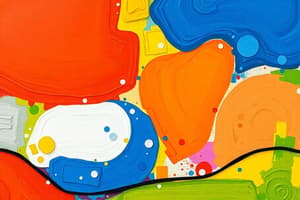Podcast
Questions and Answers
What does the business environment encompass?
What does the business environment encompass?
- Only external factors affecting a business
- Only internal factors influencing a company
- A combination of internal and external factors (correct)
- Factors unrelated to a company's operations
Which of the following is NOT a component of the PEST analysis?
Which of the following is NOT a component of the PEST analysis?
- Political Factors
- Social Factors
- Technological Factors
- Environmental Factors (correct)
How can environmental forces influence a business?
How can environmental forces influence a business?
- By solely dictating marketing strategies
- By exclusively determining employee satisfaction
- By affecting operations, ecosystems, and community interactions (correct)
- By only impacting the financial aspect of the business
What type of analysis is used to identify Strengths, Weaknesses, Opportunities, and Threats?
What type of analysis is used to identify Strengths, Weaknesses, Opportunities, and Threats?
Which of the following best defines environmental scanning?
Which of the following best defines environmental scanning?
Which macroenvironmental factor relates to population demographics?
Which macroenvironmental factor relates to population demographics?
What aspect would not be included in the microenvironment of a business?
What aspect would not be included in the microenvironment of a business?
Which of the following is an example of a political factor in PEST analysis?
Which of the following is an example of a political factor in PEST analysis?
Which of the following best describes 'Strengths' in a SWOT analysis?
Which of the following best describes 'Strengths' in a SWOT analysis?
What factors are included in the micro-environment of marketing?
What factors are included in the micro-environment of marketing?
Which of the following options is NOT considered an economic factor affecting consumer purchasing patterns?
Which of the following options is NOT considered an economic factor affecting consumer purchasing patterns?
What is discretionary income?
What is discretionary income?
Which of the following correctly defines inflation?
Which of the following correctly defines inflation?
What is the long-term benefit of new technology in terms of products?
What is the long-term benefit of new technology in terms of products?
Natural forces in marketing environment are best associated with which of the following?
Natural forces in marketing environment are best associated with which of the following?
Which of the following is not a reason for enacting legislation affecting business?
Which of the following is not a reason for enacting legislation affecting business?
What does demarketing aim to achieve?
What does demarketing aim to achieve?
Which factor is most influenced by political forces?
Which factor is most influenced by political forces?
Which of the following is identified as a macro-environmental force?
Which of the following is identified as a macro-environmental force?
What term describes reducing consumer demand to match the supply level?
What term describes reducing consumer demand to match the supply level?
What type of forces includes aspects like natural habitats and energy-efficient products?
What type of forces includes aspects like natural habitats and energy-efficient products?
What booking engine has made interactions with intermediaries more complex?
What booking engine has made interactions with intermediaries more complex?
Which of the following is a core belief transmitted across generations?
Which of the following is a core belief transmitted across generations?
What aspect of culture refers to the societal attitude toward art and beauty?
What aspect of culture refers to the societal attitude toward art and beauty?
Flashcards are hidden until you start studying
Study Notes
Business Environment
- Combination of internal and external factors influencing a company's operations.
- Factors can directly or indirectly impact success or failure.
Types of Business Environment
- Macroenvironment: Larger societal forces affecting the entire microenvironment, including demographic, economic, technological, political, and cultural forces.
- Microenvironment: Factors close to the company, such as internal capabilities and relationships with customers and suppliers.
Environmental Scanning
- Process of gathering, analyzing, and distributing information for strategic planning.
- Identifies how external conditions influence organizations and ecosystems.
PEST Analysis
- Evaluates Political, Economic, Social, and Technological factors affecting business:
- Political Factors: Government policies, trade restrictions, taxation.
- Economic Factors: Economic growth rates, inflation, interest rates impacting consumer power.
- Social Factors: Cultural trends, demographics, health consciousness affecting consumer behavior.
- Technological Factors: Advancements in technology, research and development, automation.
SWOT Analysis
- Framework for analyzing organizational performance:
- Strengths: Internal attributes that contribute to success.
- Weaknesses: Internal limitations affecting performance.
- Opportunities: External chances for growth and improvement.
- Threats: External challenges that could hinder progress.
Demographic Factors
- Study of human populations based on size, location, age, gender, race, and occupation.
Economic Factors
- Influence consumer buying power and overall market strategies:
- Inflation: Rise in prices decreasing purchasing power.
- Deflation: Decrease in prices.
- Unemployment: Percentage of actively seeking jobless individuals.
- Discretionary Income: Money available for non-essential spending after necessities.
Natural Forces
- Encompasses environmental factors that attract tourism and focus on sustainability, including conservation and clean energy.
Technological Forces
- Application of innovations leading to competitive advantages:
- Facilitates global communication and efficiency in distribution.
- Obsolescence risk for existing products due to rapid tech advancements.
Political Forces
- Marketing strategies affected by political influences, including legislation aimed at protecting competition, customer rights, and the public interest.
Cultural Forces
- Core beliefs and values shaped by society that influence consumer behavior, including:
- Language: Communication and expression within culture.
- Manners and Customs: Social etiquette and cultural practices.
- Education: Transmission of values and skills.
- Religion: Belief systems shaping behaviors and preferences.
Key Terms
- Demarketing: Strategies to reduce consumer demand to a manageable level.
- Green Movement: Advocates for marketing practices that emphasize environmental sustainability.
Studying That Suits You
Use AI to generate personalized quizzes and flashcards to suit your learning preferences.




